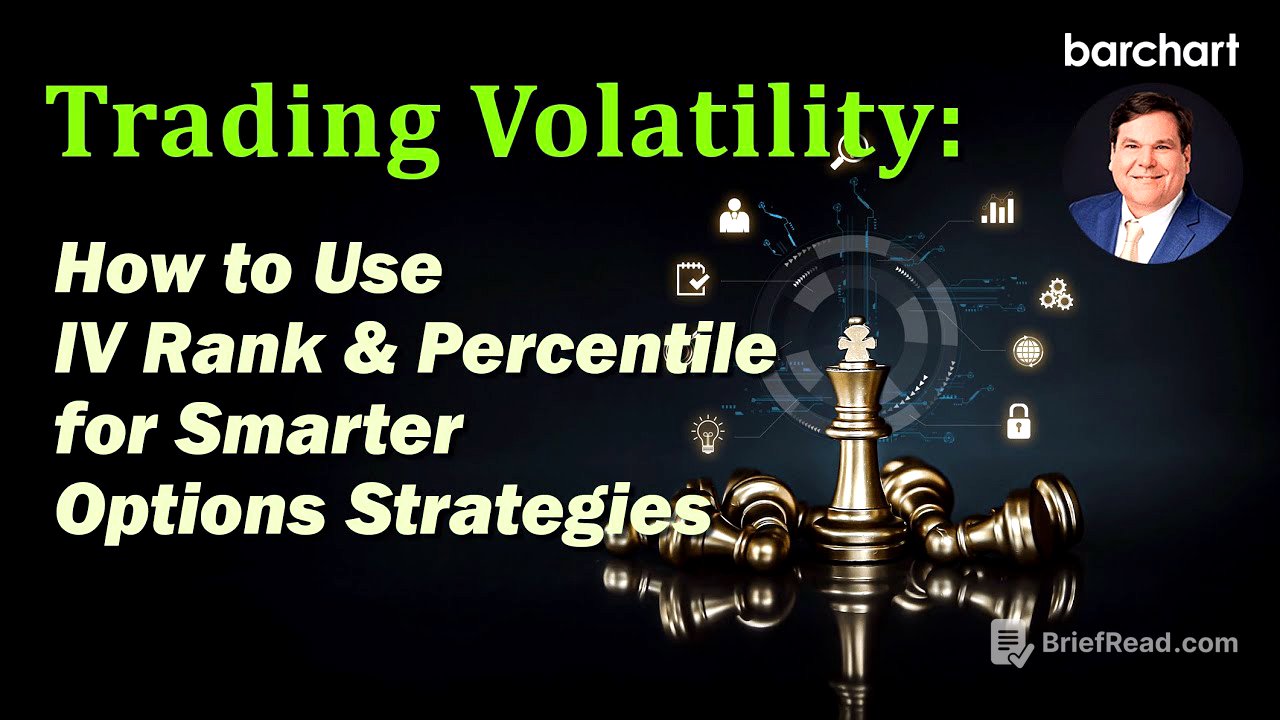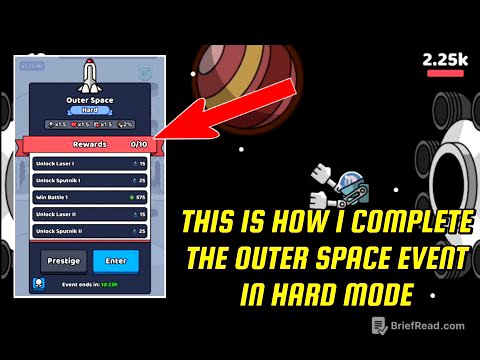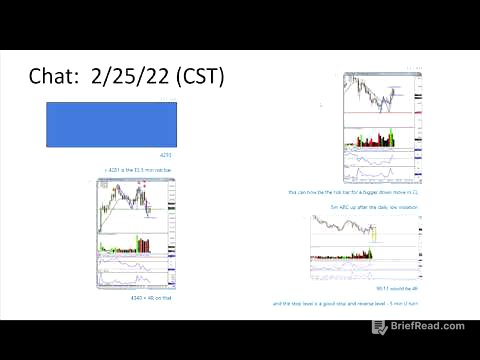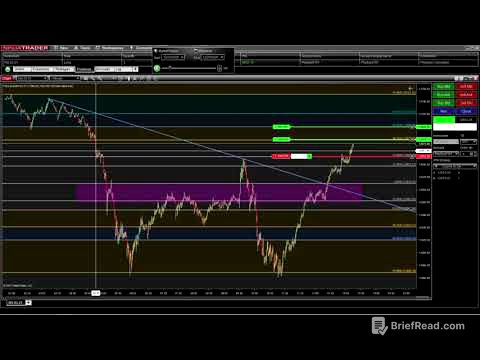TLDR;
This webinar explains how to trade volatility using implied volatility (IV) rank and percentiles to make informed options trading decisions. It covers the definition of volatility, how to gauge implied volatility using rank and percentile, and how to apply these concepts in trading strategies, including selecting the right strategy based on market conditions and directional bias.
- Implied volatility (IV) is a key factor in option pricing, reflecting market expectations of price movement.
- IV rank and percentile help traders assess whether IV is high or low relative to its past values.
- Strategy selection depends on the absolute range of the security's IV, historical volatility, and directional beliefs.
Introduction to Trading Volatility [0:05]
The webinar introduces the concept of trading volatility and using implied volatility rank and percentiles for smarter option strategies. The price of an option is determined by six inputs: underlying security price, strike price, time until expiration, dividends, interest rates, and implied volatility. The first five are known variables, while implied volatility is an unknown variable that can significantly impact option pricing, even if the underlying security price remains stable. Volatility traders take on risk opposite to the general public's opinion, capitalising on the masses' tendency to be incorrect. The key to volatility trading is understanding comparative conditions and matching them with the appropriate strategy.
Understanding Volatility: Historical vs. Implied [4:16]
Volatility is defined through historical and implied measures. Historical volatility measures how fast a security's price has changed over a specific period, representing the annualized standard deviation of price variance. It serves as a comparative tool, not a predictor. Implied volatility reflects the market's expectations of how much a security will move over the option's life. Markets often overestimate high implied volatility and underestimate low implied volatility, creating trading opportunities.
Gauging Implied Volatility: Rank and Percentile [7:02]
Implied volatility can be gauged using rank and percentile. IV rank is the at-the-money average implied volatility relative to its highest and lowest values over the past year. An IV rank of 100% indicates the highest level in the past year, suggesting strategies profiting from decreased price movement may be appropriate. An IV rank of 0% suggests strategies profiting from increased price movement may be suitable. IV percentile represents the percentage of days where implied volatility closed below the current level over the past year. A high percentage means most days had lower IV, while a low percentage means more days had higher IV. Traders may look for values above or below a threshold, such as buying opportunities below 10% and selling opportunities above 90%, considering the trend of rank and percentiles.
Applying Rank and Percentile: Strategy Selection [9:55]
Implied volatility rank and percentile provide clues about whether implied volatility is high or low, relative to itself and historical volatility. The absolute range of a security's implied volatility and its historical context determine the value of rank and percentile. A tight range means small movements in implied volatility can significantly impact rank and percentile, while a larger range results in smaller impacts. Determining the percentage of the current IV within its range and comparing it to historical volatility helps identify cheap or expensive options.
Directional vs. Nondirectional Strategies [17:48]
Strategy selection depends on whether a trader anticipates directional movement (up or down) or a range-bound market. In low implied volatility conditions, directional strategies like buying calls or puts, or using spreads like bull call or bear put spreads, can be effective. More complex strategies like long straddles are suitable when anticipating a catalyst to drive price movement and increase volatility, regardless of direction. High implied volatility conditions offer opportunities to sell covered calls or cash-secured puts. Complex, non-directional strategies like strangles capitalise on high implied volatility, expecting it to return to historical levels. Earnings announcements are a prime example of changing volatility, with implied volatility typically rising before earnings and falling dramatically after, known as the "V crush."
Barchart Tools: Implied Volatility Page [20:32]
The Barchart implied volatility page provides data including stock price changes, options volume, and the put call volume ratio, a sentiment indicator. A ratio between 0.6 and 0.8 is considered neutral, below 0.5 is bullish, and above 1.0 is bearish. Historical data on the page includes earnings history, showing elevated implied volatility before earnings and a drop afterward. The colour-coded implied volatility changes (green for higher, red for lower) help traders assess rising and falling volatility relative to rank and percentile. Rising implied volatility towards 100% rank and percentile may indicate an overestimation of price action, while large changes due to news events can present trading opportunities.
Case Study: IBM and Strangles [25:30]
Using IBM as an example, the presenter looks at the chart to gauge direction. Seeing a range-bound market since February, between 235 and 265, the presenter considers selling a strangle. The April 17th options, expiring before the earnings event, are chosen to avoid earnings-related distortions. A short strangle between 235 and 265 yields $212, with a high probability of profit. The profit and loss page visualises the data, showing potential profits, break-even points, and potential losses. The expected move for the April 17th options is inside the strangle, increasing the probability of success.
Effects of Implied Volatility on Option Prices [31:59]
Implied volatility changes affect option prices. Vega, a Greek, measures the change in option price for every 1% change in implied volatility. Rising implied volatility increases option prices for both puts and calls, while decreasing implied volatility lowers prices. Delta, another Greek, measures the change in option price for every $1 move in the underlying security and represents the probability of an option expiring in the money. High implied volatility environments lower the probability of in-the-money strikes expiring in the money, decreasing delta, while increasing the probability of out-of-the-money strikes expiring in the money, increasing delta. Rising volatility on bull call spreads may require holding the spread closer to expiration to benefit from a favourable price movement.
Low Implied Volatility and Dollar General Example [35:36]
The webinar shifts focus to low implied volatility, using the Barchart "implied vs. realised" page, sorted by the ratio of implied volatility to historical volatility. The goal is to find conditions of low implied volatility in terms of ranks and the significance of implied volatility below historical levels. Dollar General is highlighted as an example, with a historical volatility of 45.78 and a current implied volatility of 31.31. The implied volatility is at the lower end of its range, suggesting a potential improvement of 15 percentage points.
Screening for Low IV and Technical Analysis [38:11]
The presenter uses the Barchart screener to find candidates with both rank and percentile below 10%, including Dollar General. A chart analysis reveals a rising market with implied volatility at its lowest, characteristic of bull markets. The chart shows a nice rounding bottom, a bullish sign, with the stock at a potential breakout point. Historically, similar rounding bottoms have led to breakouts or violent moves to the downside, suggesting potential for increased volatility.
Dollar General: Straddle Strategy and Performance [41:11]
Given the uncertainty in direction but expectation of high volatility, a long straddle is considered for Dollar General. The May options, about 45 days out, are chosen to minimise time decay. The 85 or 90 put call combination is considered, with a bullish bias favouring the 85 spread. The profit and loss analysis shows the stock needs to move above 94 or below 75 for profit. The average true range (ATR) for Dollar General is $3, indicating the typical daily price movement. With Dollar General up 6% in the last five days, 20% in the last 20 days, and 24% in the last 50 days, a 10% movement in the next 45 days seems achievable, justifying the straddle strategy.
Q&A and Final Thoughts [46:12]
The presenter addresses audience questions, clarifying that a Barchart membership is needed to fully utilise the screening and filtering tools. High implied volatility is considered above 90%, and low below 10%. The volatility crush is explained as the transition from an unknown level of volatility before earnings to a known level after the event. The presenter emphasises that implied volatility is an essential component in determining option prices, and IV ranks and percentiles provide a relative perspective on whether an option is cheap or expensive. Understanding volatility and its role in trade selections is crucial for overall trading strategy.









